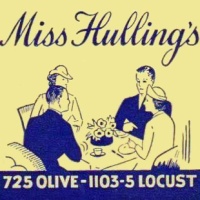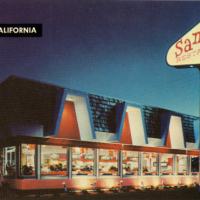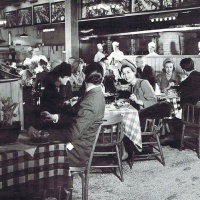Obviously there is something artificial about carving up history into decades. Everything doesn’t come to a dead stop or change unalterably from, say, January 1, 1900 to January 1, 1910. Why start a decade with a zero? Why bunch 10 years together rather than 11? Isn’t there frequently just as much continuity among decades as there is difference between one and another?
Arranging history decade by decade is a convention, and a slightly tired one at that.
But at the same time there is something appealing about decades too. If you study history and read primary documents from a particular time, you sense how it is different from other times, even ten years later. Maybe it’s superficial: the way people talk, the kind of printing used in magazines, clothing styles. These things may not be significant to historians who study broad patterns of national or continental history, but they are significant for studying ordinary, everyday businesses such as restaurants.
I’ve discovered that writing short essays on restaurant history by the decade is not an easy task. Instead of it getting easier since I wrote the first one in 2008, it’s become harder. The more I learn about the history of restaurants, the more difficult it is to capture the “essence” of a decade. One day I may look at what I’ve written and wonder why I included the details I did, or whether I totally missed the boat in characterizing the times. But for now, here are my “Tastes of the decades.”
1800 to 1810 — Taverns, oyster cellars, and coffee houses far outnumber real restaurants serving elaborate meals, which are still seen as a French invention.
 1810 to 1820 — Luxury means steak, green turtle, and oysters. An eating place is judged as much by the quality of its champagne and sherry as by its food.
1810 to 1820 — Luxury means steak, green turtle, and oysters. An eating place is judged as much by the quality of its champagne and sherry as by its food.
1820 to 1830 — Slowly but surely the nation is growing, as the number of hotels and restaurants expands. Oysters still rule as a favorite food for all classes. Public dinners honoring France’s marquis de Lafayette show just how many dishes are to be found in America’s larder.
1830 to 1840 — The French influence grows along with the number of eating places independent of hotels. Numbers of families save money by living in hotels and taking all their meals there. Temperance supporters go only to eating places that serve no hard alcohol.
1840 to 1850 — Eating out has been so British-influenced but now it starts to turn to France, the home of luxury and gourmet indulgence. Puritanical Americans fear the worst in the developing restaurant culture as they crack down on drinking.
1850 to 1860 — Restaurant excitement centers on San Francisco, where the miners have gold to spend. Chefs and cooks from all over the world head to California.
1860 to 1870 — The lunch counter is born and in San Francisco there are experiments with moving the main meal of the day to the evening rather than the middle of the day.
 1870 to 1880 — With a severe depression spreading a pall over much of the decade, people see a need for cheaper restaurants. Yet elaborate restaurants, some imported from Europe, provide a bright spot at the country’s 100th anniversary fair in Philadelphia.
1870 to 1880 — With a severe depression spreading a pall over much of the decade, people see a need for cheaper restaurants. Yet elaborate restaurants, some imported from Europe, provide a bright spot at the country’s 100th anniversary fair in Philadelphia.
1880 to 1890 — The number and quality of restaurants increases as more people live in rented rooms and hotels without meals provided. A wider variety of foods are available and prices are going down. As cities develop shopping districts, women find more places they can eat in comfort.
1890 to 1900 — Coming out of a four-year-long depression in which the breadline is a popular public eating place, the “Gay Nineties” of the century’s waning years usher in luxury dining.
 1900 to 1910 — From the champagne bubbles of the high life to the humble lunchroom where drinking coffee and eating swiftly is the thing. White collar workers want fast food.
1900 to 1910 — From the champagne bubbles of the high life to the humble lunchroom where drinking coffee and eating swiftly is the thing. White collar workers want fast food.
1910 to 1920 — Eating in restaurants continues to grow along with urbanization and expanded white collar workforces. Beginning extravagantly with cabarets and after-theater cafes, the decade ends with chain lunch rooms and cafeterias.
1920 to 1930 — Selling alcohol becomes illegal and restaurants struggle to figure out how to make money without it. Some fail, but even as luxury restaurants close the modern restaurant industry develops.
 1930 to 1940 — Restaurants lower prices and offer all-you-can-eat specials. They rejoice when Prohibition is repealed, many admitting they were on the brink of total failure.
1930 to 1940 — Restaurants lower prices and offer all-you-can-eat specials. They rejoice when Prohibition is repealed, many admitting they were on the brink of total failure.
1940 to 1950 — Due to the upheavals of war, which include unprecedented numbers of working mothers, more Americans eat out than ever before. With rationing, restaurants scramble to replace beef and sugar.
 1950 to 1960 — With the growth of suburbia and automobile culture, casual dining in drive-ins and coffee shops becomes popular with American families and the growing teen market.
1950 to 1960 — With the growth of suburbia and automobile culture, casual dining in drive-ins and coffee shops becomes popular with American families and the growing teen market.
1960 to 1970 — Fast food chains begin to spread around the country and restaurants use more and more convenience foods.
1970 to 1980 — It is the best of times and the worst of times. Fast food and theme restaurants spread rapidly, many using frozen entrees and convenience foods not requiring experienced cooks and kitchen help. At the same time, ethnic restaurants and small, innovative places whose owners serve as chef do well catering to a public that is more demanding about food and nutrition. The economy falters but Americans eat more meals away from home than ever before, marking the 1970s as the gateway to the present.
 1980 to 1990 — Once again the economy is volatile, often bad, yet dining out rates go up, up, up and dining for pleasure and entertainment becomes commonplace. Celebrity chefs emerge as do diners who crave adventurous meals. Many Americans experience new foods for the first time in restaurants, even as they continue to eat burgers and pizza at the chains.
1980 to 1990 — Once again the economy is volatile, often bad, yet dining out rates go up, up, up and dining for pleasure and entertainment becomes commonplace. Celebrity chefs emerge as do diners who crave adventurous meals. Many Americans experience new foods for the first time in restaurants, even as they continue to eat burgers and pizza at the chains.
1990 to 2000 — As fast food chains and corporate ownership groups spread, many old-time restaurants close, yet fine dining also grows and gets a boost with the initiation of the James Beard awards.













 It's great to hear from readers and I take time to answer queries. I can't always find what you are looking for, but I do appreciate getting thank yous no matter what the outcome.
It's great to hear from readers and I take time to answer queries. I can't always find what you are looking for, but I do appreciate getting thank yous no matter what the outcome.



While fascinating, the article did not address gender disparity, racism or segregation and how such affected dining for centuries.
Thanks, but those issues are worked into many of my posts, as well as being the focus of quite a few.
In answer to: “Was there an Orpheum Chinese Restaurant in downtown St.Louis back in the late 1950’s and 1960’s? As a teenager, we would take in a show at Lowe’s Theatre and have lunch at Chinese restaurant close by.”
I was able to find a digitized St. Louis City directory for 1960 and there was no restaurant listed by the name of Orpheum. If you are in St. Louis you might be able to find more directories in libraries there. They were published yearly.
Seeking photos of Xmas party taken at Board of Education party at Shales Restaurant in Webster,NY (or possibly it was in outskirts of Rochester,NY) It was in the late 1950’s when I was a co-op student working for Board of Education. There were three of us that sang (as Hillbillies) “Doing What Comes Naturally”. Just turned 80 and very nostalgic. Can you help?
I would consider those private photos, so it’s unlikely the restaurant would keep them, even in the unlikely case it still exists. Have you checked with the Board of Education?
Do you have any photos of Hicks in NYC? Thanks.
Sorry, no.
Mary Elizabeth was a restaurant in NYC with great chicken pot pie. Do you have any info about them or the recipe?
Many thanks.
Mary Elizabeth’s was one of my earliest posts. Here is the link:
Unfortunately I don’t have that recipe.
I am blown away by how fascinating your site is. My dad collected menus from the 1940s-1970s and it has been my hobby to educate others about this often neglected history. Thank you for all you do.
Pingback: Writing about Another Era? 5 Sites to Give You Inspiration with Insights | Patricia Ann Bridewell
These days, while I rejoice at the great shrinking of the food world, especially here in SoCal, I am both comforted and saddened that my growing-up years from the Forties through the Fifties, in the Midwest, formed an era in which small-town home-cooking restaurants could gain and build on a healthy measure of fame. My own town of Marshall, IL had several decent eating spots, but the clear champion was Tom’s. The meats, vegetables and other ingredients were the best Bill Koutsoumpas, the owner, could find, and the food was plain, honest and always very good. By the mid-Fifties, whenever there were SCCA sports-car races down in Lawrenceville on a weekend, Friday night would see a swarm of MGs, Jaguars, French and Italian cars I’d seen only in “Road & Track” magazine, most from St Louis or Chicago, taking up anything resembling a parking space in the blocks around Tom’s, and our location at the crossroads of US 40 and Illinois 1 assured a steady stream of travellers any day. But then they built a bypass for 40 … and after we’d moved away Interstate 70 bypassed everything. In 1974 my then-wife and I passed through, and stopped Tom’s for lunch. We had our choice of too many tables, and Bill was there looking sad and distracted. I got a cursory smile when I re-introduced myself, but it wasn’t a good time for conversation. My few visits after that, including a 40th class reunion, were a periodic tour of decay, ending for good the day I was cussed at by our waitress for wishing her a good morning …
A few years ago I rented a car at the Indianapolis airport for another reunion, this one catered and just okay. On Sunday I decided to take the old 2-lane highway back to Indy, so I could drive through all the old towns I remembered. Every one of those would have had at least three cafés on the main drag, which Old 40 was, a mere ten or twenty years before; now it was McDonald’s, Pizza Hut, Hardee’s, Big Boy and nothing else. Back in Marshall the old-timers (us!) still gather for coffee and gossip before church every Sunday morning … at McDonald’s. The coffee is almost as good as Tom’s.
My Grandfather owned a restaurant/bar in the 60’s- early 70’s called The Shrimp House on Cermak and Canal in Chicago. I was there several times. Do you know anything about it?
I had not heard of it previously, but a quick scan of newspaper stories reveals that it was fairly often the site of holdups and fights in the 1960s. A 1968 story said the owner was Albert Serrell.
I am looking for a recipe from the Kate Mantilini Restaurant which used to be in Beverly Hills, CA. It was called “Chicken With Babaganoush”, a pasta and chicken dish that was absolutely delicious.
Anything about the Cafe Chauveron? It was near the intersection of 53rd & Lexington in New York City. It closed in the early 70’s.
I’ve heard of it but I don’t have any specific research on it.
I’ve searched the internet, nothin’ there as far as photos goes…
Anything on 400 1st Street, a place called The 400 Club? Owned by Jerry Garcia’s mom.
I don’t know anything about it, but it’s definitely findable on Google.
Anyone know the name of the burger joint that was located in east end of East Liverpool Ohio, back in the ’70’s? It was located where Fagens was.
Thank you for all of the research that you do. I am loving your site.
Francine T.
Thanks!
Thank you for refreshing my memory of the name “Nantucket Cove”.
Hello, there was an upscale seafood restaurant in the lower level of a building just north of The Chase/Park Plaza that my dad used to take us to on my mom’s birthday back in the 60’s. They had a lobster tank and my mom would pick one for her birthday dinner. I can’t remember the name. Do you know what it was? Thanks.
You are undoubtedly thinking of Nantucket Cove and you might like to read this short reminiscence: http://www.stlmag.com/dining/memory-lane%3A-nantucket-cove/
Did you ever hear of Shambargers Restaurant in Redkey, IN — closed about 30 plus years ago? beigeljo@aol.com
Yes, and I have written a post about it.
Pingback: Blog Post 6: Best Source | adiowimtbaa
Pingback: Best source | History Snippets
This looks exciting!!!
I’m sure there was one in Kansas City, Mo. in Brookside on 63rd St. Check it out.
Can’t find any history on Westoaks Charbroil in Okc 10th and Rockwell and 39 Expressway and also Shawnee and Edmond — no history on internet about them or their picture logos.
They were the one on 10th and rockwell. I mostly went to the one on 39th where I worked as a dishwasher, not long though.
Just discovered your site! Looking forward to reading through.